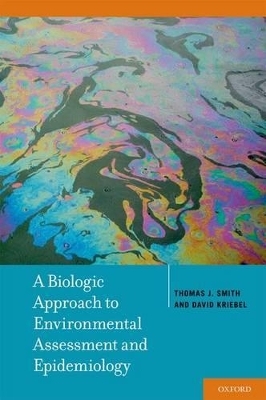
A Biologic Approach to Environmental Assessment and Epidemiology
Oxford University Press Inc (Verlag)
978-0-19-514156-6 (ISBN)
The two key fields of study on this issue, environmental epidemiology and exposure assessment, are still given separate names because of their separate historical roots and scientific traditions, but are seen increasingly as inseparable aspects of the same basic investigation. In this book, Thomas J. Smith and David Kriebel assert that important advances in the quantification of environmental risks can only come through a true synthesis of the two fields. They have built a common biologic model of exposure, physiologic response, and disease, a synthesis of the various existing models which serves to both simplify and improve the application of environmental epidemiology and exposure assessment to current and future environmental chemical risks.
When exposure assessor and epidemiologist agree from the start on the model for their study, the conceptual framework for the study they design and the analyses they carry out are much more likely to yield useful exposure-risk information. An explicit biologic model of the apparent processes linking exposure to disease should form the basis for any study seeking to quantify risk from environmental chemicals.
Thomas J. Smith, Ph.D., CIH, is Professor of Industrial Hygiene at the Harvard School of Public Health. David Kriebel, Sc.D., is Professor of Work Environment at the School of Health and Environment of the University of Massachusetts Lowell.
Chapter 1. Introduction - Relating Disease to Exposure.
Section A. Exposure and Disease in Individuals
Chapter 2. Characteristics of Exposure
Chapter 3. Exposure Characterization for Epidemiology
Chapter 4. Personal Exposure-Tissue Concentration Relationships
Chapter 5. Biomarkers as Indicators of Exposure
Chapter 6. Disease Process Models
Section B. Exposure and Disease in Populations
Chapter 7. Epidemiologic Evaluation of Environmental Hazards
Chapter 8. Uncertainty in Measuring Risk
Chapter 9. Dosimetry in Epidemiology
Section C. Practical Applications of Disease Process Models
Chapter 10. Modeling Proportional Disease Processes
Chapter 11. Effects of Ammonia and Ozone on Respiratory Symptoms: Examples of Reversible Proportional Disease Processes
Chapter 12. Neurobehavioral Effects of Mercury and Popcorn Workers' Lung: Examples of Irreversible Proportional Diseases Processes
Chapter 13. Modeling Discrete Disease Processes
Chapter 14. Asthma & Indoor Air, Dermatitis & Metalworking Fluids: Examples of Discrete Reversible Disease Processes
Chapter 15. Irreversible Discrete Processes
Chapter 16. Where Do We Go From Here?
| Erscheint lt. Verlag | 29.7.2010 |
|---|---|
| Zusatzinfo | 80 illus |
| Verlagsort | New York |
| Sprache | englisch |
| Maße | 234 x 156 mm |
| Gewicht | 798 g |
| Themenwelt | Geisteswissenschaften ► Sprach- / Literaturwissenschaft ► Sprachwissenschaft |
| Studium ► 2. Studienabschnitt (Klinik) ► Pharmakologie / Toxikologie | |
| Studium ► Querschnittsbereiche ► Epidemiologie / Med. Biometrie | |
| Studium ► Querschnittsbereiche ► Prävention / Gesundheitsförderung | |
| ISBN-10 | 0-19-514156-3 / 0195141563 |
| ISBN-13 | 978-0-19-514156-6 / 9780195141566 |
| Zustand | Neuware |
| Haben Sie eine Frage zum Produkt? |
aus dem Bereich


